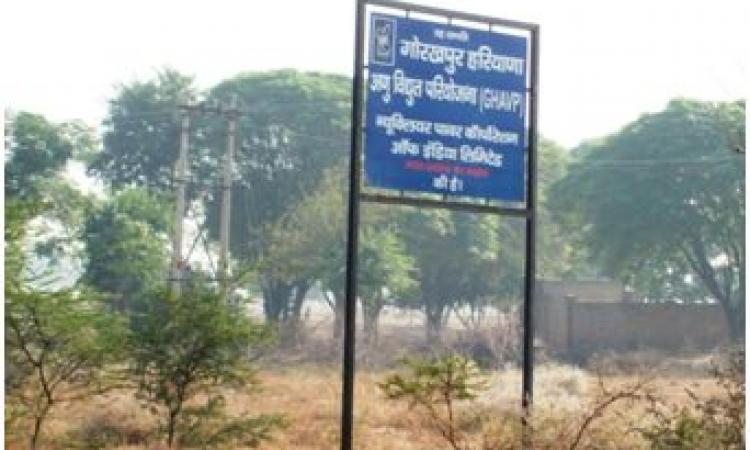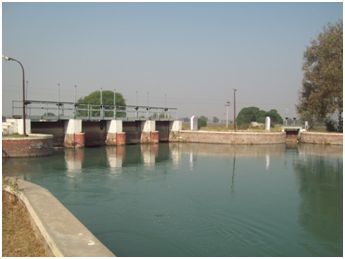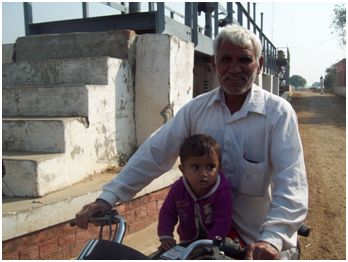
National Highway 10 passes through Badophal, a village in Fatehabad district of Haryana. The highway is lined by a tiny market and a point where several jeeps start and terminate. These jeeps are headed to Gorakhpur village, some 15 kms away via Kajal Heri, another village en route. Hordes of researchers, journalists, activists and politicians throng these three villages nowadays for it presents a familiar tale of might over right-government pushing past ecological considerations and squashing local opposition to get what they want.
A nuclear power plant this time.
Proposed at Gorakhpur, the Rs 23,502 crore project under the Haryana Atomic Power Project (HAPP) will be India’s largest indigenous nuclear power project. It is slated to have four 700 MW units. In the first phase (2020-21), two units totalling 1400 MW will be completed. The plant’s full capacity of 2800 MW is massive given that the present power generation capacity of Haryana is 5800 MW. The project will produce nuclear power apart from processing nuclear fuel.
The area
The site is located about 33 km from Hisar, a city dating back to the Indus valley civilization. The area forms a part of the irrigated tract watered by the Fatehabad branch of the Bhakra canal system in Haryana. The Fatehabad branch canal is a branch of the Bhakra main branch canal and the Gorakhpur distributary that caters to the irrigation needs of this area branches off of that. The lands acquired for the nuclear power plant fall in the head reach of the Gorakhpur distributary and the canal flows from east to west and is north of the site.
View Gorakhpur in a larger map
Water woes
The area had witnessed improved agricultural production owing to the provision of irrigation facilities. According to the Irrigation Department, “warabandi, a system of rotational water supply had been instituted in the canal command and tube wells installed in tail reaches to improve system performance and minimize inequity”. Until recently, the canal distribution network owned and operated by the State Irrigation Authorities was running well. Groups of farmers managed the water distribution beyond the outlet. The Irrigation Department had invested a lot of money in the water diversion systems in the canal system.

However, the excess or deficit of water supply and its impact on crop yields holds no meaning today. A high-level land-selection committee comprising Nuclear Power Corporation of India (NPCIL) engineers cleared the site in early 2010 following a visit to the area. With Lok Sabha elections round the corner, the Government seems firm in pushing for construction of the plant.
Water necessary to cool nuclear plants
The nuclear power plant would require water for cooling and other purposes. For this, it will draw water from the Fatehabad branch of the Bhakra Canal. This will be the first project in the world to have such a restricted source of water. In a water-constrained world, nuclear plants are generally located near oceans or rivers to provide the ample water needed for cooling purposes. “In fact, the Environment Agency of the United Kingdom recommends that all future nuclear plants be built on coastal sites. Such a location also provides salt water for a desalination facility, which can be located near a nuclear plant to make use of its heat or electricity” [1].
Nuclear power plants are water guzzling in nature. In the case of the Gorakhpur nuclear power plant the water will be consumed for cooling and other purposes while the rest will be released back into the canal. For cooling, nuclear energy consumes 400-720 gallons/MWh while coal consumes lesser, ranging from about 300-714 gallons/MWh and natural gas-fueled power plants consume even lesser, at 100-370 gallons/MWh [1].
Beware of accident at the plant!
"The water will not be enough even for normal operation and reactor cooling, what if an accident takes place?", says Dhanraj Jat, a local farmer from Gorakhpur village. In case of any accident during operation, a huge quantum of water on a continuous basis would be required as it happened in the Fukushima case. T. R. Arora, Project Director, HAPP says that they have approached the Haryana government for allocating water from the Western Yamuna Canal as an alternate source. This is a very serious issue given that many of the big nuclear accidents like Fukushima and Chernobyl have occured because of coolant failures.
Kavita, a young woman from the area says that canals are closed for maintenance every year, at times for several weeks. So there is a possibility that there will be no water for the plant at those times. Even if the two maintenance periods (nuclear plant and canal) are harmonized, there are risks of gaps because of several departments of the two states Punjab and Haryana being involved.
A regulatory requirement of the Atomic Energy Regulatory Board (AERB) is that “if the minimum water supply required for long term heat removal from the core cannot be ensured under all circumstances, then the site shall be deemed unsuitable. Availability of adequate quantity of water to maintain the reactor under safe shutdown state for at least thirty days needs to be ensured under all circumstances.” HAPP refutes these arguments and says that it will provide for massive storages to last for a month.
Irrigation water diverted
A major plank on which the protests took place was the irrigation water scarcity that would result when the proposed nuclear plant starts drawing water from the canal. Project documents reveal that the Haryana Government has assured a water supply of 783 million litres a day (or 32625 m3/hr) to the plant. This includes the requirement for the township (1.2 million litres per day or 52 m3/hr). “The water requirement has been optimized and about 18000 m3/hr of water will be required for unit 1 to 4 for cooling tower makeup and other plant requirements out of which 12680 m3/hr will be towards consumptive use and the rest of the 5320 m3/hr will be returned to canal”, as per the Environmental Impact Assessment report.
Kuldeep Singh Jat, a local farmer form Kajal heri says that allocating irrigation water for the nuclear power plant is wrong. He quickly calculates that the water diverted for the plant will deprive 1 lakh acre of farmland from irrigation. In addition, the 30% of water that will be recycled back into the Gorakhpur distributary poses a threat to drinking water and agriculture in downstream areas as it may be contaminated.
Another Fukushima or Chernobyl?
The locals fear that once the plant is up and running, inadequacies in facilities related to handling, storing or transporting inflammable or toxic material may create a catastrophe. The 2011 tsunami in Japan and the ensuing disaster in the Fukushima nuclear power plant raised safety concerns about the massive amounts of radioactive waters that were released. The incident, which led to the release of substantial amounts of radioactive matter, was the second largest nuclear disaster following Chernobyl. The contaminated water is still getting into the sea and the cleanup process is expected to take several years.
Colossal amounts of water will be required at Gorakhpur to deal with a calamity like this. More than three hundred times the present canal’s discharge will be required even for small emergencies.

Scientific studies reveal the radiation effects from the normal operation of nuclear installations including groundwater contamination. Locals fear that even in normal times, the radiation levels will not be within accepted safety standards and they would never come to know given the shred of secrecy around nuclear power plants. Even today, the local gram panchayat does not have a copy of the Environment Impact Assessment. Also, the water discharged from the plant will be much warmer (at least 5-6 degrees warmer) than at normal conditions. Will this water, if used for irrigation, not affect the crops?
While some of the locals will lose out because of diversion of canal water for plant use, others will face radiation risks due to release of ‘recycled’ water into the canal. Those living within a 30 km radius from the proposed plant are at great risk. Yet, they were not compensated.
More recently, laying the foundation stone for the plant at Gorakhpur village last month, the Prime Minister said that nuclear power is a ‘dependable, clean’ energy option for the country. The green tag is particularly distressing. The country’s nuclear establishment is lurching from one problem to the next without a coherent strategy. The meagre benefits that the land compensation provides, is no substitute for the loss of access to and control over lands and water that the people once had.
The cons outweigh the pros when it comes to nuclear energy but the government doesn't think so. We can only hope that Fatehabad doesn't become infamous like Chernobyl or Fukushima.
References
/articles/fatehabad-another-fukushima